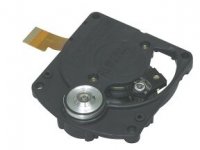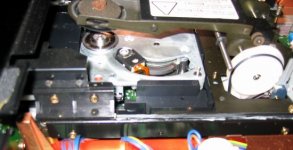yes, i still wait for an occasion of metal frame swingarm transports😎
http://www.blackpudding.fsnet.co.uk/digital_jitter/images/lasers/cdm9pro.jpg
http://www.blackpudding.fsnet.co.uk/digital_jitter/images/lasers/cdm9pro.jpg
till said:yes, i still wait for an occasion of metal frame swingarm transports😎
http://www.blackpudding.fsnet.co.uk/digital_jitter/images/lasers/cdm9pro.jpg
what's the difference between 9 and 9 pro?
the basic is also made of metal
Don't know that about CDM9, but it would probably be the more expensive cdplayers. The CDM4 Pro was used in studio/broadcasting equipment amongst others. Nevertheless cd-testing machines today still use the ordinary plastic CDM4 !
http://www.cd-qc.co.uk/qa/faq.htm
http://www.cd-qc.co.uk/qa/faq.htm
Sorry I couldn't resist, a quote from the link above mentioned:
The single-spot pickup has the advantages that it has fewer parts, better signal to noise ratio (because all the laser power is concentrated into one beam), faster access time (no gears), and lack of beam distortion due to moving the axis of the objective lens. Most importantly, it also conforms to the measurement standards in the Red Book. This is why most analyzer manufacturers, including The QA-101 all use a CDM4 single-spot pickup in their systems, and advertise it as "the standard".
The three-spot pickup on the other hand, has the advantage of maintaining a constant orientation between the beam and the pits, due to the linear tracking mechanism. It also is less sensitive to the strength of the track following signal on the disc. As a result, three-spot pickups tend to have less trouble playing certain CD-Recordable discs, which often do not meet Orange Book or Red Book specs for tracking signal. The CDM12 three-spot pickup we use is ideal for measuring jitter, since it is the pickup used by Philips to measure jitter, and meets the Orange Book specs for measuring jitter. Because the polarization of the beam is perpendicular to the tracks, it provides a sharp cutoff in the tangential direction, making for low jitter measurements. Jitter measurements made with this pickup are significantly lower than those made with single-spot pickups. There is also an argument that the three-spot pickup agrees better with the results one is likely to find in the field, since all new CD-ROM drives use three-spot pickups.
One drawback to the three-spot pickup is that it does not meet the Red Book specifications for measuring Push-Pull Tracking signal and Radial Noise. There is some debate about whether it is possible to make these measurements using a three-spot pickup, but Philips states that it is not possible.
Mmm, more jitter ? Nothing is perfect...
The single-spot pickup has the advantages that it has fewer parts, better signal to noise ratio (because all the laser power is concentrated into one beam), faster access time (no gears), and lack of beam distortion due to moving the axis of the objective lens. Most importantly, it also conforms to the measurement standards in the Red Book. This is why most analyzer manufacturers, including The QA-101 all use a CDM4 single-spot pickup in their systems, and advertise it as "the standard".
The three-spot pickup on the other hand, has the advantage of maintaining a constant orientation between the beam and the pits, due to the linear tracking mechanism. It also is less sensitive to the strength of the track following signal on the disc. As a result, three-spot pickups tend to have less trouble playing certain CD-Recordable discs, which often do not meet Orange Book or Red Book specs for tracking signal. The CDM12 three-spot pickup we use is ideal for measuring jitter, since it is the pickup used by Philips to measure jitter, and meets the Orange Book specs for measuring jitter. Because the polarization of the beam is perpendicular to the tracks, it provides a sharp cutoff in the tangential direction, making for low jitter measurements. Jitter measurements made with this pickup are significantly lower than those made with single-spot pickups. There is also an argument that the three-spot pickup agrees better with the results one is likely to find in the field, since all new CD-ROM drives use three-spot pickups.
One drawback to the three-spot pickup is that it does not meet the Red Book specifications for measuring Push-Pull Tracking signal and Radial Noise. There is some debate about whether it is possible to make these measurements using a three-spot pickup, but Philips states that it is not possible.
Mmm, more jitter ? Nothing is perfect...
CDM9 is made of sheet metal and CDM9pro is of casted metal.
I've seen CDM9 in Rotel RDD980 and CDM9pro in Marantz CD10 and CD11.
I've seen CDM9 in Rotel RDD980 and CDM9pro in Marantz CD10 and CD11.
Jean-Paul
Meridian 602 drive use CDM 4 Pro. And to me the single bean is superior: at least on opera female voice and piano;much less distortion.
Meridian 602 drive use CDM 4 Pro. And to me the single bean is superior: at least on opera female voice and piano;much less distortion.
I am doing a senior design project, building a cd player. I wanted to use the CD-PRO2, but I don't want to spend such a large chunk of the budget on the cd transport.
The only place that I can find the transport offered in the US is this place:
http://www.enco-group.com/order.htm
Does anyone else know where to obtain a cd module in the us, such as the CDM4 or CDM9 mentioned above?
--
Brian
The only place that I can find the transport offered in the US is this place:
http://www.enco-group.com/order.htm
Does anyone else know where to obtain a cd module in the us, such as the CDM4 or CDM9 mentioned above?
--
Brian
BrianGT said:I am doing a senior design project, building a cd player. I wanted to use the CD-PRO2, but I don't want to spend such a large chunk of the budget on the cd transport.
The only place that I can find the transport offered in the US is this place:
http://www.enco-group.com/order.htm
Does anyone else know where to obtain a cd module in the us, such as the CDM4 or CDM9 mentioned above?
--
Brian
the problem is that the CDM4 and CDM9 we're talking about czn't be easilly used for a diy cd player.
The CD PRO2 comes with a pcb that houses the servo, the decoder... And is ready to use with an I2S output
the CDM4/9 are only the optical part, to be used for replacement parts for out of order cd players. The cd players have all the required chips on theyr own pcb
Bricolo said:
the problem is that the CDM4 and CDM9 we're talking about czn't be easilly used for a diy cd player.
The CD PRO2 comes with a pcb that houses the servo, the decoder... And is ready to use with an I2S output
the CDM4/9 are only the optical part, to be used for replacement parts for out of order cd players. The cd players have all the required chips on theyr own pcb
Well, are there any other cd modules out there that support the dsa interface ( http://www.daisy-laser.com/tech2.htm ). I seems easy to program, and the module would need to output.
--
Brian
If the laser is gone, you might be able to swap only that. Could be that you get a plastic lense instead of glass, but you still have the metal transport. Or just replace with the standard cdm4, might not be so good (?), but you have it running again.
GuidoB
GuidoB
- Status
- Not open for further replies.
- Home
- Source & Line
- Digital Source
- Cdm-4/19

